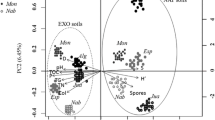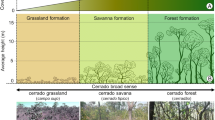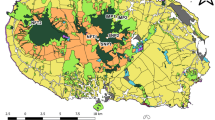Abstract
Arbuscular mycorrhizal fungi (AMF) are symbiotic fungi with a broad distribution, and many taxa have physiological and ecological adaptations to specific environments, including semiarid ecosystems. Our aim was to address regional distribution patterns of AMF communities in such semiarid environments based on spore morphological techniques. We assessed AMF spores at the bottom and top of inselbergs distributed throughout the tropical dry forest in the Northeast region of Brazil. Across 10 replicate inselbergs and the surrounding area, spanning a range of altitude between 140 and 2000 m, we scored the AMF soil diversity and properties in 52 plots. We fitted parsimonious ordination analyses and variance partitioning models to determine the environmental factors which explained the variation in AMF community, based on morphological spore analysis. The diversity of AMF was similar at the bottom and top of inselbergs; however, we detected high variation in abundance and richness across sites. We formulated a parsimonious richness model that used physical soil factors as predictors. The AMF community structure could be best explained through the variables coarse and total sand, iron, organic matter, potassium, silt, and sodium which together accounted for 17.8% of total variance. Several AMF species were indicators of either deficiency or high values of specific soil properties. We demonstrated that habitat isolation of the inselbergs compared with surrounding areas did not trigger differences in AMF communities in semiarid regions of Brazil. At the regional scale, soil predictors across sites drove the distribution of symbiotic mycorrhizal fungi.






Similar content being viewed by others
References
Santos R, Barbosa A, Almeida H, et al. (2011) Structure and floristics of a remnant of arboreous caatinga in Juvenília, northern Minas Gerais, Brazil. Cerne 17:247–258
Prado D (2003) As Caatingas da América do Sul. In: Lea I, Tabarelli M, Silva J (eds) Ecol. e Conserv. da Caatingas, 1st ed. Editora Universitária da UFPE, Recife, pp 3–74
Porembski S, Martinelli G, Ohlemuller R, Barthlott W (1998) Diversity and ecology of saxicolous vegetation mats on inselbergs in the Brazilian Atlantic rainforest. Divers Distrib 4:107–119. doi:10.1046/j.1365-2699.1998.00013.x
Pires GG, dos Santos RM, Tristão RA, et al. (2014) Influência de variáveis ambientais na comunidade arbórea de inselbergs. Cerne 20:97–104. doi:10.1590/S0104-77602014000100013
Camargo-Ricalde SL, Esperón-Rodríguez M (2005) Efecto de la heterogeneidad espacial y estacional del suelo sobre la abundancia de esporas de hongos micorrizógenos arbusculares en el valle semiárido de Tehuacán-Cuicatlán, México. Rev Biol Trop 53:339–352. doi:10.4067/S0718-16202007000300006
Klironomos J, Zobel M, Tibbett M, et al. (2011) Forces that structure plant communities: quantifying the importance of the mycorrhizal symbiosis. New Phytol 189:366–370. doi:10.1111/j.1469-8137.2010.03550.x
Rillig MC (2004) Arbuscular mycorrhizae and terrestrial ecosystem processes. Ecol Lett 7:740–754. doi:10.1111/j.1461-0248.2004.00620.x
Newsham KK, Fitter AH, Watkinson AR (1995) Multi-functionality and biodiversity in arbuscular mycorrhizas. Trends Ecol Evol 10:407–411. doi:10.1016/S0169-5347(00)89157-0
Augé RM (2001) Water relations, drought and vesicular-arbuscular mycorrhizal symbiosis. Mycorrhiza 11:3–42. doi:10.1007/s005720100097
Veresoglou SD, Rillig MC (2012) Suppression of fungal and nematode plant pathogens through arbuscular mycorrhizal fungi. Biol Lett 8:214–217. doi:10.1098/rsbl.2011.0874
Veresoglou SD, Halley JM, Rillig MC (2015) Extinction risk of soil biota. Nat Commun 6:1–10. doi:10.1038/ncomms9862
Averill C, Turner BL, Finzi AC (2014) Mycorrhiza-mediated competition between plants and decomposers drives soil carbon storage. Nature 505:543–545. doi:10.1038/nature12901
Rillig MC, Mummey DL (2006) Mycorrhizas and soil structure. New Phytol 171:41–53. doi:10.1111/j.1469-8137.2006.01750.x
Klironomos JN, McCune J, Hart M, Neville J (2000) The influence of arbuscular mycorrhizae on the relationship between plant diversity and productivity. Ecol Lett 3:137–141. doi:10.1046/j.1461-0248.2000.00131.x
Rosendahl S (2008) Communities, populations and individuals of arbuscular mycorrhizal fungi. New Phytol 178:253–266. doi:10.1111/j.1469-8137.2008.02378.x
Wubet T, Weiß M, Kottke I, et al. (2004) Molecular diversity of arbuscular mycorrhizal fungi in Prunus africana, an endangered medicinal tree species in dry Afromontane forests of Ethiopia. New Phytol 161:517–528. doi:10.1046/j.1469-8137.2003.00924.x
Martínez-García LB, Richardson SJ, Tylianakis JM, et al. (2015) Host identity is a dominant driver of mycorrhizal fungal community composition during ecosystem development. New Phytol 205:1565–1576. doi:10.1111/nph.13226
Xu T, Veresoglou SD, Chen Y, et al. (2016) Plant community, geographic distance and abiotic factors play different roles in predicting AMF biogeography at the regional scale in northern China. Environ Microbiol Rep 8:1048–1057. doi:10.1111/1758-2229.12485
Overby ST, Owen SM, Hart SC, et al. (2015) Soil microbial community resilience with tree thinning in a 40-year-old experimental ponderosa pine forest. Appl Soil Ecol 93:1–10. doi:10.1016/j.apsoil.2015.03.012
Säle V, Aguilera P, Laczko E, et al. (2015) Impact of conservation tillage and organic farming on the diversity of arbuscular mycorrhizal fungi. Soil Biol Biochem 84:38–52. doi:10.1016/j.soilbio.2015.02.005
Wetzel K, Silva G, Matczinski U, et al. (2014) Superior differentiation of arbuscular mycorrhizal fungal communities from till and no-till plots by morphological spore identification when compared to T-RFLP. Soil Biol Biochem 72:88–96. doi:10.1016/j.soilbio.2014.01.033
Vályi K, Mardhiah U, Rillig MC, Hempel S (2016) Community assembly and coexistence in communities of arbuscular mycorrhizal fungi. ISME J 10:2341–2351. doi:10.1038/ismej.2016.46
Veresoglou SD, Caruso T, Rillig MC (2013) Modelling the environmental and soil factors that shape the niches of two common arbuscular mycorrhizal fungal families. Plant Soil 368:507–518. doi:10.1007/s11104-012-1531-x
Lekberg Y, Koide RT, Rohr JR, et al. (2007) Role of niche restrictions and dispersal in the composition of arbuscular mycorrhizal fungal communities. J Ecol 95:95–105. doi:10.1111/j.1365-2745.2006.01193.x
Sikes BA, Powell JR, Rillig MC (2010) Deciphering the relative contributions of multiple functions within plant–microbe symbioses. Ecol Model 91:1591–1597
Jansa J, Erb A, Oberholzer HR, et al. (2014) Soil and geography are more important determinants of indigenous arbuscular mycorrhizal communities than management practices in Swiss agricultural soils. Mol Ecol 23:2118–2135. doi:10.1111/mec.12706
Pasternak Z, Al-Ashhab A, Gatica J, et al. (2013) Spatial and temporal biogeography of soil microbial communities in arid and semiarid regions. PLoS One 8:e69705. doi:10.1371/journal.pone.0069705
Dumbrell AJ, Nelson M, Helgason T, et al. (2010) Idiosyncrasy and overdominance in the structure of natural communities of arbuscular mycorrhizal fungi: is there a role for stochastic processes? J Ecol 98:419–428. doi:10.1111/j.1365-2745.2009.01622.x
Ab’Sáber AN (1999) Dossiê Nordeste seco. Estud Avançados 13:5–59
Velloso AL, Giulietti AM, Oren DC, et al (2002) Ecorregiões—Propostas para o Bioma Caatinga. In: Recife APNE, Nat. Conserv. do Bras. p 80
Gomes P, Alves M (2009) Floristic and vegetational aspects of an inselberg in the semi-arid region of Northeast Brazil Edinburgh. J Bot 66:329. doi:10.1017/S0960428609005241
Gerdemann JW, Nicolson TH (1963) Spores of mycorrhizal Endogone species extracted from soil by wet sieving and decanting. Trans Br Mycol Soc 46:235–244. doi:10.1016/S0007-1536(63)80079-0
Jenkins W (1964) A rapid centrifugal-flotation technique for separating nematodes from soil. Plant Dis Rep 48:692
Hijmans RJ, Cameron SE, Parra JL, et al. (2005) Very high resolution interpolated climate surfaces for global land areas. Int J Climatol 25:1965–1978. doi:10.1002/joc.1276
Legendre P, Gallagher ED (2001) Ecologically meaningful transformations for ordination of species data. Oecologia 129:271–280. doi:10.1007/s004420100716
Oksanen AJ, Blanchet FG, Friendly M, et al (2016) The Vegan Package. Community Ecol. Packag
Legendre P (2008) Studying beta diversity: ecological variation partitioning by multiple regression and canonical analysis. J Plant Ecol 1:3–8. doi:10.1093/jpe/rtm001
Cáceres M, Jansen F (2015) Package “ indicspecies ”—relationship between species and groups of sites
Core Team R (2013) R: a language and environment for statistical computing. R Foundation for Statistical Computing, Vienna,
Öpik M, Vanatoa A, Vanatoa E, et al. (2010) The online database MaarjAM reveals global and ecosystemic distribution patterns in arbuscular mycorrhizal fungi (Glomeromycota). New Phytol 188:223–241. doi:10.1111/j.1469-8137.2010.03334.x
Kivlin SN, Hawkes CV, Treseder KK (2011) Global diversity and distribution of arbuscular mycorrhizal fungi. Soil Biol Biochem 43:2294–2303. doi:10.1016/j.soilbio.2011.07.012
Martínez-García LB, Armas C, Miranda J de D, et al. (2011) Shrubs influence arbuscular mycorrhizal fungi communities in a semi-arid environment. Soil Biol Biochem 43:682–689. doi:10.1016/j.soilbio.2010.12.006
Davison J, Moora M, Opik M, et al. (2015) Global assessment of arbuscular mycorrhizal fungus diversity reveals very low endemism. Science 349:970–973. doi:10.1126/science.aab1161
Pontes J, Oehl F, Marinho F, et al. (2017) Diversity of arbuscular mycorrhizal fungi in Brazil’s Caatinga and experimental agroecosystems. Biotropica, In Press
Chaudhary VB, O’Dell TE, Rillig MC, Johnson NC (2014) Multiscale patterns of arbuscular mycorrhizal fungal abundance and diversity in semiarid shrublands. Fungal Ecol 12:32–43. doi:10.1016/j.funeco.2014.06.003
Öpik M, Davison J (2016) Uniting species- and community-oriented approaches to understand arbuscular mycorrhizal fungal diversity. Fungal Ecol 24:106–113. doi:10.1016/j.funeco.2016.07.005
Taylor A, Walker C, Bending GD (2013) Dimorphic spore production in the genus Acaulospora. Mycoscience 55:1–4. doi:10.1016/j.myc.2013.03.001
Antoninka AJ, Ritchie ME, Johnson NC (2015) The hidden Serengeti—mycorrhizal fungi respond to environmental gradients. Pedobiologia (Jena) 58:165–176. doi:10.1016/j.pedobi.2015.08.001
Porembski S (2007) Tropical inselbergs: habitat types, adaptive strategies and diversity patterns. Rev Bras Bot 30:579–586. doi:10.1590/S0100-84042007000400004
Diaz HF, Grosjean M, Graumlich L (2003) Climate variability and change in high elevation regions: past, present and future. Clim Chang 59:1–4. doi:10.1023/A:1024416227887
Soethe N, Lehmann J, Engels C (2008) Nutrient availability at different altitudes in a tropical montane forest in Ecuador. J Trop Ecol 24:397–406. doi:10.1017/S026646740800504X
Koske RE, Tews LL (1987) Vesicular-arbuscular mycorrhizal fungi of Wisconsin sandy soils. Mycologia 79:901. doi:10.2307/3807694
Wiens JJ, Donoghue MJ (2004) Historical biogeography, ecology and species richness. Trends Ecol Evol 19:639–644. doi:10.1016/j.tree.2004.09.011
Treseder KK, Maltz MR, Hawkins BA, et al. (2014) Evolutionary histories of soil fungi are reflected in their large-scale biogeography. Ecol Lett 17:1086–1093. doi:10.1111/ele.12311
Brown J (1995) Macroecology. The University of Chicago Press, Chicago,
Svenning J-C, Skov F (2005) The relative roles of environment and history as controls of tree species composition and richness in Europe. J Biogeogr 32:1019–1033. doi:10.1111/j.1365-2699.2005.01219.x
Duivenvoorden JF (2002) ECOLOGY: beta diversity in tropical forests. Science 295(80):636–637. doi:10.1126/science.295.5555.636
Lauber CL, Strickland MS, Bradford MA, Fierer N (2008) The influence of soil properties on the structure of bacterial and fungal communities across land-use types. Soil Biol Biochem 40:2407–2415. doi:10.1016/j.soilbio.2008.05.021
de Gannes V, Eudoxie G, Bekele I, Hickey WJ (2015) Relations of microbiome characteristics to edaphic properties of tropical soils from Trinidad. Front Microbiol 6:1–13. doi:10.3389/fmicb.2015.01045
Thougnon Islas AJ, Hernandez Guijarro K, Eyherabide M, et al. (2016) Can soil properties and agricultural land use affect arbuscular mycorrhizal fungal communities indigenous from the Argentinean Pampas soils? Appl Soil Ecol 101:47–56. doi:10.1016/j.apsoil.2016.01.005
Oehl F, Laczko E, Bogenrieder A, et al. (2010) Soil type and land use intensity determine the composition of arbuscular mycorrhizal fungal communities. Soil Biol Biochem 42:724–738. doi:10.1016/j.soilbio.2010.01.006
Pumpanen J, Ilvesniemi H, Hari P (2003) A process-based model for predicting soil carbon dioxide efflux and concentration. Soil Sci Soc Am J 67:402. doi:10.2136/sssaj2003.4020
Chaudhary VB, Lau MK, Johnson NC (2008) Macroecology of microbes—biogeography of the Glomeromycota. Mycorrhiza. Springer, Berlin, pp. 529–563
Hu Y, Rillig MC, Xiang D, et al. (2013) Changes of AM fungal abundance along environmental gradients in the arid and semi-arid grasslands of northern China. PLoS One 8:e57593. doi:10.1371/journal.pone.0057593
Marschner H (2011) Mineral nutrition of higher plants, third. Academic Press, London,
Subbarao GV, Ito O, Berry WL, Wheeler RM (2003) Sodium—a functional plant nutrient. CRC Crit Rev Plant Sci 22:391–416. doi:10.1080/748638747
Gattward JN, Almeida AAF, Souza JO, et al. (2012) Sodium-potassium synergism in Theobroma cacao: stimulation of photosynthesis, water-use efficiency and mineral nutrition. Physiol Plant 146:350–362. doi:10.1111/j.1399-3054.2012.01621.x
Campanelli A, Ruta C, De MG, Morone-Fortunato I (2013) The role of arbuscular mycorrhizal fungi in alleviating salt stress in Medicago sativa L. var icon. Symbiosis 59:65–76. doi:10.1007/s13199-012-0191-1
Krishnasamy K, Bell R, Ma Q (2014) Wheat responses to sodium vary with potassium use efficiency of cultivars. Front Plant Sci 5:631. doi:10.3389/fpls.2014.00631
Castelletti C, Santos A, Tabarelli M, Silva J (2003) Quanto ainda resta da Caatinga? Uma estimativa preliminar. In: Leal I, Tabarelli M, Silva J (eds) Ecol. e Conserv. da Caatinga, First. Recife, pp 719–734
Caravaca F, Alguacil MM, Vassileva M, et al. (2004) AM fungi inoculation and addition of microbially-treated dry olive cake-enhanced afforestation of a desertified Mediterranean site. Land Degrad Dev 15:153–161. doi:10.1002/ldr.600
Miransari M (2010) Contribution of arbuscular mycorrhizal symbiosis to plant growth under different types of soil stress. Plant Biol 2:563–569. doi:10.1111/j.1438-8677.2009.00308.x
Mardukhi B, Rejali F, Daei G, et al. (2015) Mineral uptake of mycorrhizal wheat ( Triticum aestivum L.) under salinity stress. Commun Soil Sci Plant Anal 46:343–357. doi:10.1080/00103624.2014.981271
Johnson NC, Tilman D, Wedin D (1992) Plant and soil controls on mycorrhizal fungal communities. Ecology 73:2034–2042. doi:10.2307/1941453
de Assis DMA, Oehl F, Gonçalves CM, et al. (2016) Community structure of arbuscular mycorrhizal fungi in fluvial and maritime dunes of Brazilian Northeast. Appl Soil Ecol 108:136–146. doi:10.1016/j.apsoil.2016.07.018
Hart MM, Reader RJ (2002) Does percent root length colonization and soil hyphal length reflect the extent of colonization for all AMF? Mycorrhiza 12:297–301. doi:10.1007/s00572-002-0186-5
Varela-Cervero S, López-García Á, Barea JM, Azcón-Aguilar C (2016) Differences in the composition of arbuscular mycorrhizal fungal communities promoted by different propagule forms from a Mediterranean shrubland. Mycorrhiza 26:489–496. doi:10.1007/s00572-016-0687-2
Klironomos JN, Hart MM (2002) Colonization of roots by arbuscular mycorrhizal fungi using different sources of inoculum. Mycorrhiza 12:181–184. doi:10.1007/s00572-002-0169-6
Acknowledgements
The authors would like to thank Coordenação de aperfeiçoamento de pessoal de nível superior (CAPES), proc.: 1374510, and the Conselho Nacional de Desenvolvimento Científico e Tecnológico (CNPq), proc.: 206415/2014-1 for financial support of the research and authors’ collaboration.
Author information
Authors and Affiliations
Corresponding author
Ethics declarations
Conflict of Interest
The authors declare that they have no conflict of interest.
Electronic supplementary material
ESM 1
(DOCX 15 kb)
Rights and permissions
About this article
Cite this article
Sousa, N.M.F., Veresoglou, S.D., Oehl, F. et al. Predictors of Arbuscular Mycorrhizal Fungal Communities in the Brazilian Tropical Dry Forest. Microb Ecol 75, 447–458 (2018). https://doi.org/10.1007/s00248-017-1042-7
Received:
Accepted:
Published:
Issue Date:
DOI: https://doi.org/10.1007/s00248-017-1042-7




